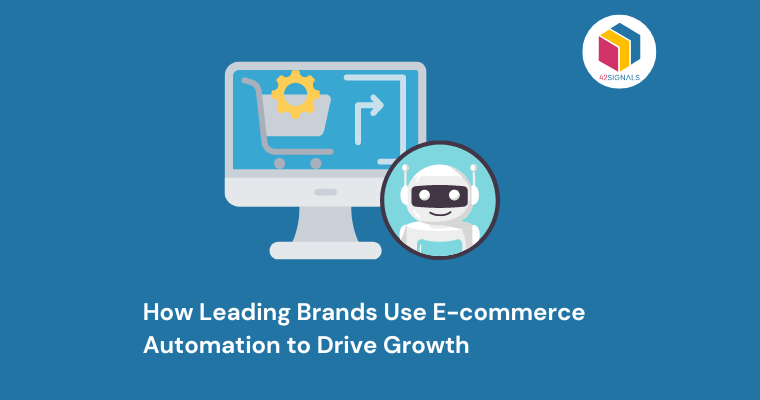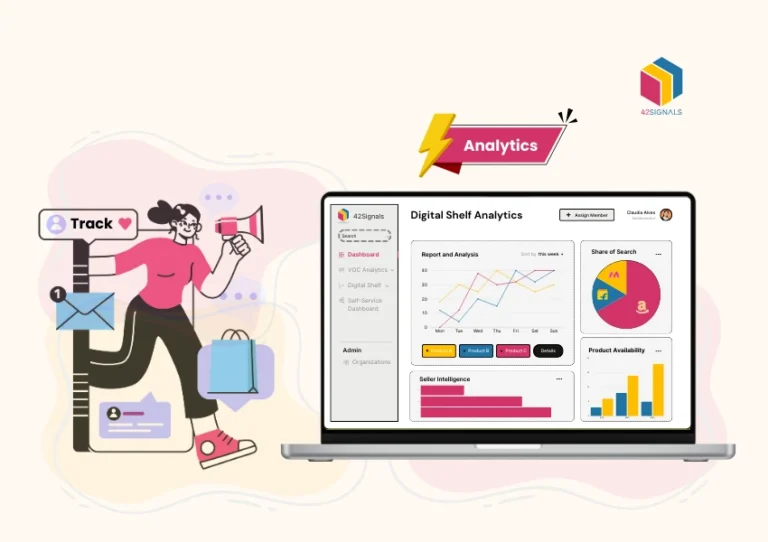Table of Contents
ToggleWhat is Ecommerce Automation? How Does it Work?
Ecommerce automation involves using software and tools to streamline repetitive tasks and optimize business processes in online retail. Automated systems can manage various functions like:
- Inventory management
- Order processing
- Customer service
- Marketing campaigns
- Data analysis
These tools work by integrating with existing e-commerce platforms, utilizing algorithms and triggers to perform tasks without manual intervention. Consequently, businesses can operate more efficiently, reduce human error, and focus on strategic growth initiatives. Ecommerce automation not only saves time and resources but also enhances customer experience by ensuring timely and accurate service delivery.

Image Source: BotPenguin
What is The Importance of Ecommerce Automation?
Ecommerce automation is becoming critical due to its ability to streamline complex processes, increase efficiency, and significantly reduce operational costs. Leading B2C and D2C brands harness it to foster a seamless customer experience and gain a competitive edge. Companies automate repetitive tasks like inventory management, order processing, and customer service, freeing human resources to focus on strategic initiatives.
This technology also allows for personalized marketing campaigns through data analysis, ensuring targeted customer engagement. The adoption of automation tools is essential for brands aiming for scalability and sustainability in an ever-evolving digital market.
Here are six key ecommerce automation technologies reshaping the industry and driving success for modern online retailers:
Beyond Efficiency: The Multifaceted Importance of Ecommerce Automation
- Scalability Without Proportional Overhead: Manual processes inherently bottleneck growth. Adding more orders typically meant adding more staff for customer service, order processing, and inventory checks – a linear cost increase that erodes margins. Automation decouples growth from headcount inflation. An automated fulfillment system can process 100 orders as efficiently as 1,000 within its capacity limits. Chatbots handle thousands of simultaneous inquiries without needing more agents. This allows businesses to scale revenue significantly without a corresponding explosion in operational costs, protecting profitability and enabling ambitious expansion plans. For emerging brands and SMBs, this levels the playing field against larger competitors.
- Hyper-Personalization at Scale: Today’s consumers expect brands to understand their individual preferences and history. Manually tailoring every marketing message, product recommendation, or service interaction for thousands of customers is impossible. Automation, fueled by AI and data analytics, makes this a reality. By analyzing browsing behavior, purchase history, demographics, and engagement patterns in real-time, automation tools dynamically personalize:
- Email Marketing: Sending abandoned cart reminders, browse abandonment sequences, post-purchase follow-ups, and re-engagement campaigns tailored to individual actions and preferences.
- Website Experience: Displaying personalized product recommendations, dynamic content blocks, and targeted promotions based on user profiles.
- Loyalty Programs: Offering personalized rewards and tier benefits automatically.
- Customer Service: Providing agents with instant access to a customer’s complete history and predicted needs. This level of personalization dramatically boosts conversion rates, average order value (AOV), and customer lifetime value (CLTV).
- Enhanced Accuracy and Reduced Errors: Humans are prone to fatigue and mistakes, especially with repetitive tasks. Manual data entry for orders, inventory updates, or shipping labels leads to costly errors: shipping the wrong item, billing inaccuracies, overselling stock, or failing to flag potential fraud. Automation systems execute these tasks with near-perfect precision, 24/7. This translates to:
- Fewer shipping mistakes and costly returns.
- Accurate inventory levels preventing overselling and stockouts.
- Correct billing and payment processing.
- Improved fraud detection consistency.
- Enhanced customer trust and satisfaction.
- Superior Customer Experience & Loyalty: Automation isn’t about replacing human interaction; it’s about enhancing it and making it more efficient and effective.
- 24/7 Availability: Chatbots and self-service portals provide instant answers to common questions anytime, anywhere, meeting the modern expectation for immediate support.
- Faster Resolution: Automated ticketing systems route inquiries to the right agent instantly, reducing hold times and resolution periods. Order status updates are automated.
- Proactive Engagement: Automated alerts for shipping delays or back-in-stock notifications keep customers informed without them needing to ask.
- Seamless Journeys: Automation stitches together touchpoints (e.g., abandoned cart email triggering after leaving the site, followed by a personalized recommendation email). This consistent, frictionless experience fosters loyalty and positive word-of-mouth.
- Data-Driven Decision Making & Optimization: Automation platforms generate vast amounts of granular data on every aspect of the operation. Crucially, they also aggregate and analyze this data, providing actionable insights that would be impossible to glean manually:
- Marketing Performance: Precise attribution modeling showing which automated campaigns drive the most revenue and highest CLTV.
- Inventory Forecasting: Predictive analytics based on sales trends, seasonality, and promotions to optimize stock levels and purchasing.
- Customer Behavior Analysis: Identifying high-value segments, understanding drop-off points in the funnel, and uncovering product affinities.
- Operational Efficiency Metrics: Pinpointing bottlenecks in fulfillment, returns processing, or customer service response times. This data empowers strategic decisions, resource allocation, and continuous optimization of all business functions.
- Operational Resilience & Risk Mitigation: Automation builds a more robust and adaptable business.
- Reduced Staff Dependency: Less vulnerable to staff turnover, illness, or fluctuations in workload.
- Consistency: Ensures processes are followed correctly every time, regardless of who (or what) is executing them.
- Faster Adaptation: Automated rules can be quickly adjusted to respond to market changes, promotions, or supply chain disruptions.
- Compliance: Automated systems can enforce regulatory requirements (e.g., data handling, tax calculations) more reliably.
- Disaster Recovery: Automated backups and cloud-based systems ensure critical operations can continue even during physical disruptions.
Deep Dive: Key Technologies Reshaping Ecommerce Automation
- AI-Powered Chatbots & Virtual Assistants:
- Beyond FAQ: Modern chatbots handle complex queries, process returns/refunds, track orders, and even make product recommendations using NLP and machine learning.
- Seamless Handoff: Intelligently escalate complex issues to human agents with full context, reducing customer frustration.
- Proactive Engagement: Initiate conversations based on user behavior (e.g., offering help after prolonged browsing).
- Intelligent Inventory Management Systems:
- Real-Time Syncing: Centralized view across warehouses, stores, and 3PLs.
- Predictive Replenishment: AI forecasts demand down to the SKU level, automating purchase orders to prevent stockouts and minimize excess inventory costs.
- Safety Stock Optimization: Dynamically calculates optimal safety stock levels based on lead times and demand variability.
- Multi-Channel Management: Synchronizes inventory seamlessly across online store, marketplaces (Amazon, eBay), and physical locations.
- Sophisticated Email & SMS Marketing Automation:
- Behavioral Trigger Journeys: Complex sequences triggered by specific actions (e.g., welcome series, post-purchase nurture, win-back campaigns for lapsed customers).
- Dynamic Content: Emails populated with personalized product recommendations, content, and offers unique to each recipient.
- Segmentation & Personalization Engines: Advanced tools create granular segments based on behavior, demographics, purchase history, and predicted lifetime value, enabling highly targeted messaging.
- A/B Testing Automation: Test subject lines, content, and send times automatically to continuously optimize performance.
- End-to-End Order Fulfillment Automation:
- Warehouse Management Systems (WMS): Optimize pick paths, manage packing stations, automate label printing, and integrate with shipping carriers for best-rate selection.
- Automated Shipping & Tracking: Instantaneous generation of shipping labels, customs forms, and automated tracking emails upon shipment.
- Returns Management Automation (RMA): Self-service return portals, automated return label generation, restocking rules, and refund processing streamline the reverse logistics nightmare.
- Integrated Customer Relationship Management (CRM) & Customer Data Platforms (CDP):
- 360-Degree Customer View: Aggregates data from all touchpoints (website, email, social, support, purchases) into a single, unified profile.
- Automated Lead Scoring & Nurturing: Qualifies leads based on behavior and engagement, automatically moving them through tailored nurture sequences.
- Sales Force Automation: Automates tasks for sales teams (lead assignment, follow-up reminders, quote generation).
- Service Automation: Automates ticket routing, SLA tracking, and knowledge base suggestions for agents.
- Seamless Payment Gateway Integration & Fraud Prevention:
- One-Click & Digital Wallets: Enable frictionless payments like Apple Pay, Google Pay, PayPal.
- Automated Tax & Duty Calculation: Real-time, accurate calculation of complex global tax rules and duties at checkout.
- AI-Powered Fraud Detection: Analyzes transactions in milliseconds using machine learning models to identify and block fraudulent attempts while minimizing false declines that lose legitimate sales.
- Subscription & Recurring Billing: Automates complex billing cycles, dunning management (failed payment retries), and customer notifications.
Emerging Frontiers:
- Predictive Analytics & Personalization Engines: Moving beyond reactive personalization to anticipating customer needs and surfacing relevant products/content proactively.
- Voice Commerce Automation: Integrating with smart speakers for voice-activated ordering and status checks.
- Automated Social Commerce: Managing direct sales, customer service, and personalized advertising within social platforms.
- Sustainable Operations Automation: Optimizing packaging, logistics routes, and inventory to minimize environmental impact.
Implementation: Strategy is Key
Adopting automation isn’t merely about buying tools. Success requires:
Start Small, Scale Fast: Pilot automation in one key area (e.g., abandoned cart emails), measure results, and expand strategically
Process Mapping: Identify repetitive, error-prone, or high-volume tasks ripe for automation.
Clear Goals: Define specific, measurable objectives (e.g., reduce cart abandonment by 15%, cut fulfillment time by 30%).
Integration Focus: Ensure new tools integrate seamlessly with existing tech stack (ecommerce platform, ERP, CRM).
Data Foundation: Clean, structured data is the fuel for effective automation.
Change Management: Prepare and train staff for new workflows; automation frees them for higher-value strategic and creative tasks.
The Landscape of B2C and D2C E-commerce
The landscape of B2C (Business-to-Consumer) and D2C (Direct-to-Consumer) e-commerce is evolving rapidly, driven by increased digital adoption and changing consumer preferences. B2C e-commerce typically involves intermediaries and marketplaces connecting consumers to a wide range of products, whereas D2C focuses on brands selling directly to consumers through their own online platforms. Key trends include:
- The rise of mobile commerce
- Personalization and AI-driven customer experiences
- Seamless omnichannel strategies
Both models emphasize user-friendly interfaces, fast delivery, and efficient customer service to meet growing consumer expectations and stay competitive.

Image Source: Tallyfy
How B2C Brands Utilize Automation for Customer Engagement?
B2C brands leverage ecommerce automation to enhance customer engagement by employing sophisticated tools that streamline communication. These brands use chatbots to provide real-time support, reducing response times and improving customer satisfaction. Personalized email campaigns are automated, ensuring timely and relevant content delivery based on user behavior and preferences.
Social media automation tools engage audiences through scheduled posts and targeted ads, maintaining a consistent brand presence. Loyalty programs are managed automatically, rewarding customers for their interactions without manual intervention. Additionally, automated feedback systems gather insights seamlessly, enabling continuous improvement in service offerings.
Ecommerce Automation Strategies for Optimizing D2C Sales
Personalized Email Campaigns in ECommerce Automation
- Utilize customer data for targeted email content.
- Automate product recommendations based on browsing history.
Dynamic Pricing
- Implement algorithms to adjust prices according to demand.
- Monitor competitor pricing and automatically reprice products.
Inventory Management
- Use AI for demand forecasting.
- Automate stock replenishment to prevent overstock and stockouts.
Customer Service Automation
- Deploy chatbots for 24/7 customer support.
- Implement automated ticketing systems.
Marketing Campaign Optimization
- Use A/B testing tools for continuous improvement.
- Automate ad bidding based on performance metrics.
Order Fulfillment Automation
- Integrate with fulfillment centers for real-time updates.
- Automate shipping notifications and tracking updates.
Streamlining Operations and Fulfillment through Automation
Leading B2C and D2C brands leverage automation to enhance operational efficiency and fulfillment processes. These brands optimize supply chain management, inventory tracking, and order processing by utilizing technologies such as artificial intelligence (AI) and machine learning (ML). Key automation tools include:
- Automated Warehousing Systems: Utilize robots for picking, packing, and shelving.
- AI-driven Inventory Management: Predict demand and manage stock levels seamlessly.
- Order Processing Software: Automates invoicing, shipping labels, and customer notifications.
These innovations enable brands to minimize human error, reduce operational costs, and accelerate delivery times, ultimately leading to improved customer satisfaction.
Personalization and Customer Experience Automation
B2C and D2C brands harness the power of ecommerce automation to deliver highly personalized customer experiences at scale. By leveraging AI-driven tools, these companies can analyze vast amounts of customer data to create tailored product recommendations, personalized email campaigns, and dynamic website content.
Automation allows for real-time adjustments based on individual customer behavior and preferences, ensuring that the shopping experience is both relevant and engaging. Furthermore, automated customer service features such as chatbots and personalized interaction flows streamline support, enhancing overall customer satisfaction and loyalty while reducing operational costs.
Examples of Ecommerce Automation
Customer Service Automation:
Top brands utilize chatbots and AI-driven solutions to handle customer inquiries, providing quick and accurate responses 24/7. This reduces the need for human intervention and enhances user experience.
Inventory Management Automation:
Leading companies implement inventory management systems that automatically update stock levels, reorder products, and track shipments. This ensures optimal stock levels, minimizes human error, and streamlines the supply chain.
Personalized Marketing Automation:
Successful brands deploy automation tools to personalize email marketing campaigns, recommend products based on past purchases, and retarget customers with customized ads. This helps in increasing customer engagement and boosting sales.

Image Source: Weblime
Challenges and Solutions in Ecommerce Automation
While incorporating ecommerce automation, B2C brand, and D2C brands may face certain challenges, including:
Data Integration Issues
Brands often face difficulties integrating various data sources. Using APIs and middleware can streamline this process.
System Complexity
Complex systems can hinder automation. Simplifying workflows and adopting user-friendly platforms can mitigate this.
High Initial Costs
The initial investment in automation tools is high. Opting for scalable, cloud-based solutions can reduce upfront expenses.
Security Concerns
Automation could expose vulnerabilities. Implementing robust cybersecurity measures is crucial.
Staff Resistance
Employees may resist new technologies. Providing comprehensive training and highlighting benefits can ease transitions.
Customizability
Pre-built solutions may lack customization. Opt for flexible tools that allow extensive personalization.
Conclusion on ECommerce Automation
B2C and D2C brands must harness ecommerce automation to sustain growth in today’s competitive market. 42Signals offers advanced analytics and intelligent automation solutions to help businesses scale rapidly and efficiently. By leveraging data-driven insights, brands can enhance customer experiences, streamline operations, and boost profitability.
With 42Signals, businesses can stay ahead of the curve, optimizing their e-commerce strategies for maximum impact. Contact us today to discover how their cutting-edge technology can transform your e-commerce operations and drive unprecedented growth.




